Tourism for All
Inclusive Tourism
“Accessible Tourism” refers to tourism that caters to the needs of a full range of consumers including persons with disabilities, older persons and cross-generational families.
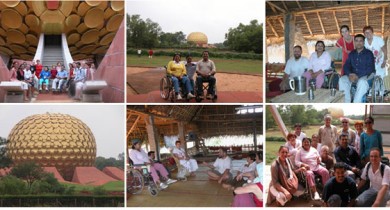
Achievements to make Incredible India- Accessible India
Samarthyam showcased the famous Dilli Haat project at INA that a tourist site can be easily made accessible in partnership with government and architecture firm.
Dilli Haat (INA, Pritampura & Janakpuri) vibrant urban space in the heart of Delhi provides a rich cultural and interactive tourist experience for people of all ages. Accessible features including ramps, railings, even flooring and accessible toilets were added in 2004-06 that have made it inclusive and a joy for all who visit and further promote it.
Following the success of Dilli Haat, INA with the addition of accessible elements post-occupancy, the Delhi government got a much needed impetus to promote barrier free environments. In partnership with Delhi Tourism and Transport Development Corporation (DTTDC) and architect Mr. Pradeep Sachdeva, Samarthyam promoted inclusive design in the Garden of Five Senses and Plazas at Emporia Complex, Connaught Place in Delhi.
Further impetus from the UNCRPD has led to access audits and retrofits of CPWD 50 prime public buildings in New Delhi with Ministry of Urban Development (now know as Ministry of Housing & Urban Affairs), Government of India. These 50 buildings include museums like the National Museum and National Archives and prime government buildings and campuses such as North and South Block, Prime Minister’s office, President House (Rashtrapati Bhawan), Supreme Court, etc.
In public transport infrastructure projects, the Delhi Metro and BRT low floor buses enhance connectivity for tourists. DTTDC has also started “HOHO” hop in -hop off low floor accessible bus for Delhi city sightseeing during the Commonwealth Games 2010, which still continues to attract foreign and domestic tourists with disability.
In Delhi, Red Fort, Purana Quila (Old Fort), Safdarjung Tomb, Jantar Mantar, Qutub Minar and Humayun’s Tomb were access audited and these sites have been made accessible for persons with disabilities and persons with reduced mobility (senior citizens, pregnant women, families with young children and persons with temporary ailments).
In Odisha, Samarthyam has access audited the Sun Temple at Konark, a World Heritage Site and 10 key temples. Director General, ASI and other concerned agencies are involved in implementing access audit report recommendations for making them accessible. The Sun Temple at Konark currently is fairly accessible for tourists and is a remarkable example for public private partnership and Samarthyam DPO technical expertise on universal accessibility.
Partnership with Archeological Survey of India (ASI), Ministry of Tourism & Culture, Govt. of India
2018, ASI and Samarthyam signed an MoU to make all ticketed monuments in Delhi accessible and inclusive. Under the Accessible India Campaign, this was the city wise initiative to make World heritage Sites and other monuments accessible for tourist and staff with disabilities and reduced mobility. Samarthyam access audited Qutub Minar, the Red Fort, Humayun’s Tomb, Safdarjung Tomb, Purana Qila (Old Fort of Delhi), etc.
2015, Samarthyam in partnership with UNESCO and India Railways undertook heritage management study of Bandra station, Mumbai. Samarthyam technical team facilitated accessibility and safety audit for passengers and employees with disabilities, girls and women including those with disabilities and elderly persons. This is a unique project where in the Bandra station is access audited as a model project and will be replicated in other stations of Mumbai to promote and implement universal accessible and safety design standards.
2014-15, Samarthyam has partnered with UNESCO and ASI to make the World Heritage Monuments accessible for all. With Ministry of Social Justice & Empowerment’s support, Samarthyam access audited Humayun’s Tomb. UNESCO and ASI is working to make the site barrier free and improving access for people with disabilities and reduced mobility.
2012, Samarthyam has initiated project with the ASI Delhi and Odisha Circle to promote universal accessible features. In Odisha, Konark (Sun) Temple, a World Heritage Site and 10 key temples are access audited. ASI and other concerned agencies are involved in implementing access audit report recommendations for making these temples accessible
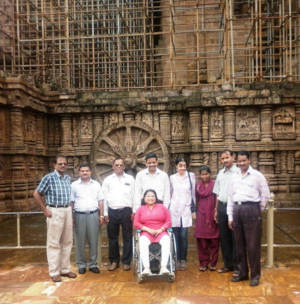
2008, Samarthyam was invited to vet the plan of Qutub Minar by Delhi, Cirle ASI and provide recommendations for universal accessibility. Currently, Samarthyam is working to promote accessibility in world heritage sites and ticketed monuments of East and South India
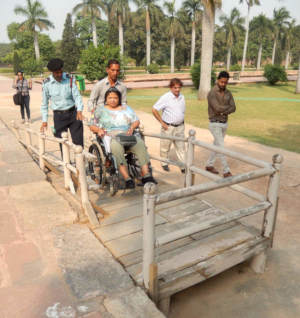
2004, Samarthyam was invited to conduct access audit of Janter Manter (heritage monument). All these efforts have received a great deal of positive media coverage with regular articles in all of India’s daily national newspapers. The result is an overall increased awareness of the issue of accessibility within the community, the commercial sector and with in Government.
2003, ASI has offered to work hand in hand with Samarthyam to make other popular historical monuments barrier free. Qutub Minar, Humayun’s Tomb and Puranan Quila were selected and Samarthyam team provided technical expertise to ensure that all ASI monuments are accessible to all.
2001, ASI had issued an order and took Samarthyam as technical expert to make all historical monuments accessible for persons with disabilities. Access audits of Safdarjung Tomb, which also houses the office of the Superintendent Archaeologist (Delhi Circle); Janter Manter and other frequently visited monuments were conducted. The Superintendent Archaeologist welcomed Samarthyam’s suggestion of disabled friendly toilets. Braille information plates describing the history of the monument were mounted in December 2001 as the first step towards ‘inclusion and accessible tourism’.
Accessible Plazas at Emporia Complex, Connaught Place, New Delhi
Pradeep Sachdeva Design Associates (PSDA) was commissioned to design the space in front of the Emporium Complex buildings near Connaught Place by the New Delhi Municipal Corporation (NDMC). Samarthyam conducted access audit of the Emporia complex and provided recommendations to make the site universally accessible.
The space has been has been redeveloped as a pedestrian plaza and is now a shopper’s paradise accessed by millions of domestic and international tourists. Equipped with all inclusive features such as an upper level walkway links the various state emporia, and an amphitheatre and kiosks have been provided at the lower level walkway along with parking facilities.
Both levels are connected by ramps and steps and are barrier-free with level differences clearly demarcated by tactile paving. The Emporia complex is a shoppers delight
Dilli Haat, Aurobindo Marg, New Delhi
‘Dilli Haat’ – a food & crafts bazaar has emerged as one of Delhi’s most loved urban leisure spaces. Designed to be a public space- it is a platform for showcasing regional crafts and foods of India. The site was reclaimed by covering a storm water drain – the ‘Khushk Nallah’ with a slab. Dilli Haat is a place of celebration; an ever-changing kaleidoscope of crafts and cuisines from different parts of India. The project was designed for the Delhi Tourism and Transportation Development Corporation (DTTDC) by PSDA Studio and opened in 1994.
Samarthyam worked with DTTDC and PSDA Studio to help retrofit Dilli Haat and make it barrier-free. Key Interventions undertaken included:
- Leveling of front plaza flooring
- Demarcated pathway for mobility aid users movement
- Lowering of ticket counter
- Merging of level differences with 27 small and big ramps with handrails
- Unisex accessible toilet (the first accessible toilet in a tourist place)
Dilli Haat is the first accessible tourist spot in India and it has received National Award (President’s Award) for Promotion of Barrier Free Environment (BFE) on 3rd December 2005, International World Disability Day. This project established a template for other such projects including the Dilli Haat at Pitampura, Garden of Five Senses, etc.
Awareness and Excursion Tours
Since 1996- till date, Samarthyam has organized more than 88 tours for persons with severe disabilities to places of historical, cultural, religious and tourist interests’, promoting the concept of Accessible Tourism.
Some of the places visited include Agra, Mathura, Bharatpur, Jaipur, Udaipur, Mt. Abu, Ahmedabad, Vadodra, Mata Vaishno Devi Shrine, Dalhousie, Chamba, Amritsar, Shimla, Kurushetra, Rishikesh, Mussoorie, Nainital, Lucknow, Kolkata, Hyderabad, Mysore, Chennai, Tirupati, Goa, Port Blair, Bangalore, Guwahati and Shillong etc.
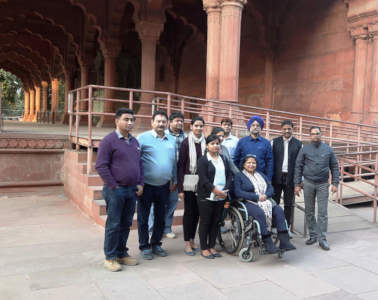
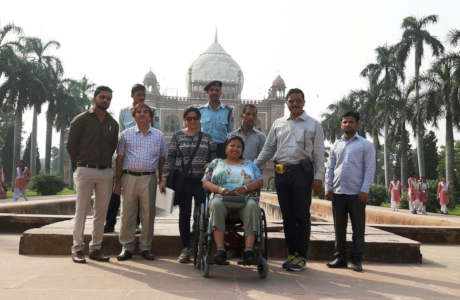
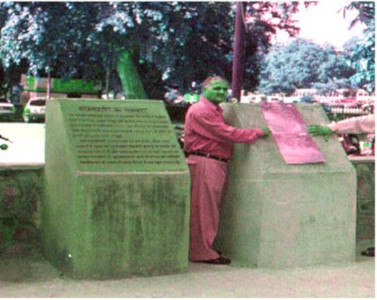
Guides to Help Your Business Benefit from Accessibility
- Best Practice in Accessible Tourism Inclusion, Disability, Ageing Population and Tourism Authors : Dimitrios Buhalis, Simon Darcy, Ivor Ambrose Available for purchase at http://accessibletourismresearch.blogspot.ca/ external
- Accessible Tourism Concepts and Issues Authors : Dimitrios Buhalis, Simon Darcy Available for purchase at http://accessibletourismresearch.blogspot.ca/ external
- “Recommendations on Accessible Tourism” from World Tourism Organization, UNWTO http://dtxtq4w60xqpw.cloudfront.net/sites/all/files/docpdf/accesibilityenok.pdf Download PDF external Provides recommendations to ensure that tourism opportunities are accessible. It addresses accessibility in all aspects of the ‘tourism chain’ from advertising to transportation to facilities to cultural activities.
- “Manual on Accessible Tourism for All: Public-Private Partnerships and Good Practices” http://dtxtq4w60xqpw.cloudfront.net/sites/all/files/docpdf Download PDF external This manual was developed through the collaboration of the UNWTO and disabled persons’ organizations. It can assist tourism providers to increase the accessibility of facilities, services and destinations.
- “Improving Information on Accessible Tourism for Disabled People” prepared by Jacqueline Westcott and published by the European Commission. http://ec.europa.eu/enterprise/sectors/tourism/files/studies/en.pdf Download PDF external Provides guidance on how tourist facilities can improve their accessibility. It includes ‘fact sheets’ that can be filled out by tourism providers and will provide important information that someone with a disability would value in planning their trip.
- “Accessible Tourism: Unlocking the Potential” http://www.visitscotland.org/business_support/advice_materials/advicelink_guides external A Scotland based organization that offers resources for improving accessibility of tourism. Includes a free online Accessible Tourism Training Programme that is designed for managers and front line staff of tourism based establishments. It also offers the guide, “Easy Does It” which suggests a number of simple low-cost solutions to improve accessibility.
- “Accessible Tourism, It’s Your Business” http://www.tourism.vic.gov.au/business-tools-support/accessible-tourism.html#toolkitexternal An accessibility resource kit designed out of Victoria, Australia to assist their tourism industry to become more accessible.

